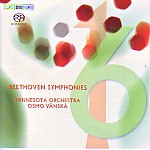Osmo Vänskä’s Beethoven cycle with his own Minnesota Orchestra represents a triumph of basic musical values as much as keen interpretive insight. This is particularly worth pointing out today, when listeners are bombarded with “new” approaches to Beethoven, ranging from “period instrument” interpretations, which frankly are getting old, to Pletnev’s recent “return to Romanticism” vision of coldly calculated, perverse tempo manipulations masquerading as 19th-century spontaneity. So let’s be clear. No period instrument group in existence can play this music as well as a superbly trained, regularly constituted major symphony orchestra such as we find here, and no blathering about different approaches to Beethoven has more inherent interest or staying power than the vision of a conductor in command of Beethoven’s idiom, able to express his ideas about the music in terms of what the score self-evidently requires, as opposed to whatever distorted nonsense can be imposed on it.
All of this is a prelude to the fact that once again Vänskä has turned in two outstanding performances. To understand how it’s possible to make the music sound fresh, alive, and yes, “different”, while remaining stylistically on point, consider three examples from the First Symphony. At the initial forte outburst in the opening movement’s first subject, listen to how Vänskä and his players energize the texture by making the accompaniment in the strings unusually clear and present, but still in balance. Next, pay particular attention to the delicious woodwind detailing that gives the second subject a welcome wash of color. Finally, note the exceptional rhythmic precision from the violins in the fanfare figures that immediately follow. And this is all just in the exposition of the First Symphony. In these two minutes of music you will find more interpretive musical substance than in several competing cycles I could name, and believe me, the remainder of the work is just as illuminating.
After the Ninth, the “Pastoral” symphony just might be the most difficult of all the symphonies to carry off successfully, largely on account of the extreme placidity of the musical surfaces in the first two movements. They have to be gorgeously played, flow as easily as, well, water in a stream, but still have sufficient energy and contrast to sustain their ample length. Solutions such as Pletnev’s, in which arbitrary tempo disruptions accompany a glacially mechanical handling of rhythm and phrasing, only exacerbate the problem. Vänskä once again finds all that he needs in what the score plainly says. I’m thinking now of the first movement’s second subject, with its unprecedented clarity of texture permitting the melody to well up through the orchestra, from strings to woodwinds, like a bubbling spring. Or consider the exquisite woodwind playing in the second movement, floating atop a perfectly judged accompaniment that never allows this brook to meander into a bog.
Vänskä’s handling of the scherzo is as rustic and lusty as anyone could ask, the precision of the playing in the country dance episodes only adding to the music’s uninhibited sense of abandon, and the storm manages to be at once powerfully graphic but also sensitively shaped and phrased when considered purely as music. The transition to the finale also is particularly evocative, and after a truly joyous “Hymn of Thanksgiving” the final pages have all of the warmth and glow that Beethoven’s pellucid scoring exudes–without ever letting us forget the basic tempo that steers the music so satisfyingly into the concluding chords.
The outstanding SACD sonics let nothing stand between the listener and a visceral encounter with Beethoven’s genius. These performances represent the difference between interpretations whose curiosity value rapidly wanes with each encounter, revealing a musically hollow core, and those–such as we find here–that have genuine staying-power and substance. They are permanently enjoyable. [12/20/2007]
































